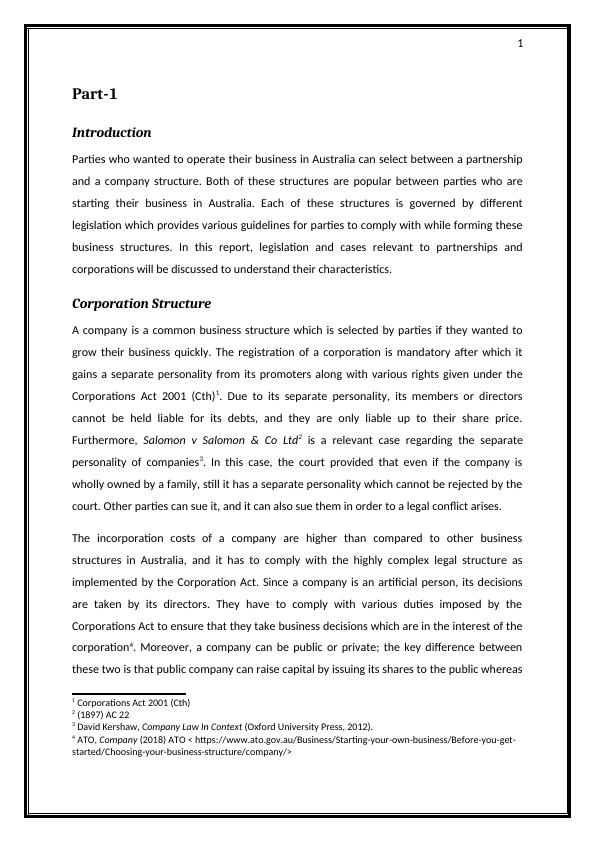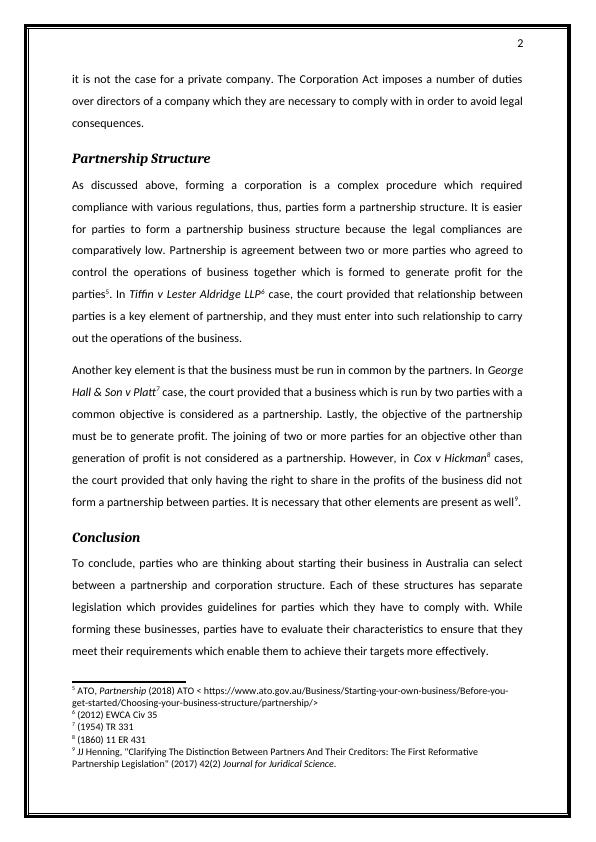Partnership and Corporation Structures in Australia
Added on 2023-06-10
13 Pages3505 Words468 Views
0
Student Name
Student Number
Word count:
Part 1:
Part 2:
Part 3:
Student Name
Student Number
Word count:
Part 1:
Part 2:
Part 3:

1
Part-1
Introduction
Parties who wanted to operate their business in Australia can select between a partnership
and a company structure. Both of these structures are popular between parties who are
starting their business in Australia. Each of these structures is governed by different
legislation which provides various guidelines for parties to comply with while forming these
business structures. In this report, legislation and cases relevant to partnerships and
corporations will be discussed to understand their characteristics.
Corporation Structure
A company is a common business structure which is selected by parties if they wanted to
grow their business quickly. The registration of a corporation is mandatory after which it
gains a separate personality from its promoters along with various rights given under the
Corporations Act 2001 (Cth)1. Due to its separate personality, its members or directors
cannot be held liable for its debts, and they are only liable up to their share price.
Furthermore, Salomon v Salomon & Co Ltd2 is a relevant case regarding the separate
personality of companies3. In this case, the court provided that even if the company is
wholly owned by a family, still it has a separate personality which cannot be rejected by the
court. Other parties can sue it, and it can also sue them in order to a legal conflict arises.
The incorporation costs of a company are higher than compared to other business
structures in Australia, and it has to comply with the highly complex legal structure as
implemented by the Corporation Act. Since a company is an artificial person, its decisions
are taken by its directors. They have to comply with various duties imposed by the
Corporations Act to ensure that they take business decisions which are in the interest of the
corporation4. Moreover, a company can be public or private; the key difference between
these two is that public company can raise capital by issuing its shares to the public whereas
1 Corporations Act 2001 (Cth)
2 (1897) AC 22
3 David Kershaw, Company Law In Context (Oxford University Press, 2012).
4 ATO, Company (2018) ATO < https://www.ato.gov.au/Business/Starting-your-own-business/Before-you-get-
started/Choosing-your-business-structure/company/>
Part-1
Introduction
Parties who wanted to operate their business in Australia can select between a partnership
and a company structure. Both of these structures are popular between parties who are
starting their business in Australia. Each of these structures is governed by different
legislation which provides various guidelines for parties to comply with while forming these
business structures. In this report, legislation and cases relevant to partnerships and
corporations will be discussed to understand their characteristics.
Corporation Structure
A company is a common business structure which is selected by parties if they wanted to
grow their business quickly. The registration of a corporation is mandatory after which it
gains a separate personality from its promoters along with various rights given under the
Corporations Act 2001 (Cth)1. Due to its separate personality, its members or directors
cannot be held liable for its debts, and they are only liable up to their share price.
Furthermore, Salomon v Salomon & Co Ltd2 is a relevant case regarding the separate
personality of companies3. In this case, the court provided that even if the company is
wholly owned by a family, still it has a separate personality which cannot be rejected by the
court. Other parties can sue it, and it can also sue them in order to a legal conflict arises.
The incorporation costs of a company are higher than compared to other business
structures in Australia, and it has to comply with the highly complex legal structure as
implemented by the Corporation Act. Since a company is an artificial person, its decisions
are taken by its directors. They have to comply with various duties imposed by the
Corporations Act to ensure that they take business decisions which are in the interest of the
corporation4. Moreover, a company can be public or private; the key difference between
these two is that public company can raise capital by issuing its shares to the public whereas
1 Corporations Act 2001 (Cth)
2 (1897) AC 22
3 David Kershaw, Company Law In Context (Oxford University Press, 2012).
4 ATO, Company (2018) ATO < https://www.ato.gov.au/Business/Starting-your-own-business/Before-you-get-
started/Choosing-your-business-structure/company/>

2
it is not the case for a private company. The Corporation Act imposes a number of duties
over directors of a company which they are necessary to comply with in order to avoid legal
consequences.
Partnership Structure
As discussed above, forming a corporation is a complex procedure which required
compliance with various regulations, thus, parties form a partnership structure. It is easier
for parties to form a partnership business structure because the legal compliances are
comparatively low. Partnership is agreement between two or more parties who agreed to
control the operations of business together which is formed to generate profit for the
parties5. In Tiffin v Lester Aldridge LLP6 case, the court provided that relationship between
parties is a key element of partnership, and they must enter into such relationship to carry
out the operations of the business.
Another key element is that the business must be run in common by the partners. In George
Hall & Son v Platt7 case, the court provided that a business which is run by two parties with a
common objective is considered as a partnership. Lastly, the objective of the partnership
must be to generate profit. The joining of two or more parties for an objective other than
generation of profit is not considered as a partnership. However, in Cox v Hickman8 cases,
the court provided that only having the right to share in the profits of the business did not
form a partnership between parties. It is necessary that other elements are present as well9.
Conclusion
To conclude, parties who are thinking about starting their business in Australia can select
between a partnership and corporation structure. Each of these structures has separate
legislation which provides guidelines for parties which they have to comply with. While
forming these businesses, parties have to evaluate their characteristics to ensure that they
meet their requirements which enable them to achieve their targets more effectively.
5 ATO, Partnership (2018) ATO < https://www.ato.gov.au/Business/Starting-your-own-business/Before-you-
get-started/Choosing-your-business-structure/partnership/>
6 (2012) EWCA Civ 35
7 (1954) TR 331
8 (1860) 11 ER 431
9 JJ Henning, "Clarifying The Distinction Between Partners And Their Creditors: The First Reformative
Partnership Legislation" (2017) 42(2) Journal for Juridical Science.
it is not the case for a private company. The Corporation Act imposes a number of duties
over directors of a company which they are necessary to comply with in order to avoid legal
consequences.
Partnership Structure
As discussed above, forming a corporation is a complex procedure which required
compliance with various regulations, thus, parties form a partnership structure. It is easier
for parties to form a partnership business structure because the legal compliances are
comparatively low. Partnership is agreement between two or more parties who agreed to
control the operations of business together which is formed to generate profit for the
parties5. In Tiffin v Lester Aldridge LLP6 case, the court provided that relationship between
parties is a key element of partnership, and they must enter into such relationship to carry
out the operations of the business.
Another key element is that the business must be run in common by the partners. In George
Hall & Son v Platt7 case, the court provided that a business which is run by two parties with a
common objective is considered as a partnership. Lastly, the objective of the partnership
must be to generate profit. The joining of two or more parties for an objective other than
generation of profit is not considered as a partnership. However, in Cox v Hickman8 cases,
the court provided that only having the right to share in the profits of the business did not
form a partnership between parties. It is necessary that other elements are present as well9.
Conclusion
To conclude, parties who are thinking about starting their business in Australia can select
between a partnership and corporation structure. Each of these structures has separate
legislation which provides guidelines for parties which they have to comply with. While
forming these businesses, parties have to evaluate their characteristics to ensure that they
meet their requirements which enable them to achieve their targets more effectively.
5 ATO, Partnership (2018) ATO < https://www.ato.gov.au/Business/Starting-your-own-business/Before-you-
get-started/Choosing-your-business-structure/partnership/>
6 (2012) EWCA Civ 35
7 (1954) TR 331
8 (1860) 11 ER 431
9 JJ Henning, "Clarifying The Distinction Between Partners And Their Creditors: The First Reformative
Partnership Legislation" (2017) 42(2) Journal for Juridical Science.

3

End of preview
Want to access all the pages? Upload your documents or become a member.
Related Documents
Liability of a Holding Company for the Negligence of its Subsidiarylg...
|9
|2477
|184
Advantages and Disadvantages of Incorporating a Company in Australialg...
|6
|1612
|162
Director Duties and Liabilities under the Corporations Actlg...
|7
|2395
|454
Legal Actions Against Susan and Mary for Violation of Corporations Actlg...
|8
|2192
|187
Violation of Director Duties in Corporate Lawlg...
|7
|2464
|293
Commercial and Corporation Law Case Study Analysislg...
|7
|1425
|426